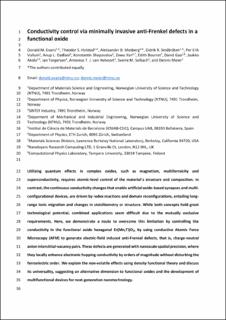| dc.contributor.author | Evans, Donald | |
| dc.contributor.author | Holstad, Theodor Secanell | |
| dc.contributor.author | Mosberg, Aleksander Buseth | |
| dc.contributor.author | Småbråten, Didrik Rene | |
| dc.contributor.author | Vullum, Per Erik | |
| dc.contributor.author | Dadlani, Anup | |
| dc.contributor.author | Shapovalov, Konstantin | |
| dc.contributor.author | Yan, Zewu | |
| dc.contributor.author | Bourret, Edith | |
| dc.contributor.author | Gao, David Zhe | |
| dc.contributor.author | Akola, Jaakko | |
| dc.contributor.author | Torgersen, Jan | |
| dc.contributor.author | Van Helvoort, Antonius | |
| dc.contributor.author | Selbach, Sverre Magnus | |
| dc.contributor.author | Meier, Dennis | |
| dc.date.accessioned | 2022-01-05T08:01:41Z | |
| dc.date.available | 2022-01-05T08:01:41Z | |
| dc.date.created | 2020-09-04T11:06:50Z | |
| dc.date.issued | 2020 | |
| dc.identifier.citation | Nature Materials. 2020, 19 1195-1200. | en_US |
| dc.identifier.issn | 1476-1122 | |
| dc.identifier.uri | https://hdl.handle.net/11250/2836078 | |
| dc.description.abstract | Utilizing quantum effects in complex oxides, such as magnetism, multiferroicity and superconductivity, requires atomic-level control of the material’s structure and composition. In contrast, the continuous conductivity changes that enable artificial oxide-based synapses and multiconfigurational devices are driven by redox reactions and domain reconfigurations, which entail long-range ionic migration and changes in stoichiometry or structure. Although both concepts hold great technological potential, combined applications seem difficult due to the mutually exclusive requirements. Here we demonstrate a route to overcome this limitation by controlling the conductivity in the functional oxide hexagonal Er(Mn,Ti)O3 by using conductive atomic force microscopy to generate electric-field induced anti-Frenkel defects, that is, charge-neutral interstitial–vacancy pairs. These defects are generated with nanoscale spatial precision to locally enhance the electronic hopping conductivity by orders of magnitude without disturbing the ferroelectric order. We explain the non-volatile effects using density functional theory and discuss its universality, suggesting an alternative dimension to functional oxides and the development of multifunctional devices for next-generation nanotechnology. | en_US |
| dc.language.iso | eng | en_US |
| dc.publisher | Nature Research | en_US |
| dc.title | Conductivity control via minimally invasive anti-Frenkel defects in a functional oxide | en_US |
| dc.type | Peer reviewed | en_US |
| dc.type | Journal article | en_US |
| dc.description.version | acceptedVersion | en_US |
| dc.rights.holder | © 2020. This is the authors' accepted and refereed manuscript to the article. The final authenticated version is available online at: http://dx.doi.org/10.1038/s41563-020-0765-x | en_US |
| dc.source.pagenumber | 1195-1200 | en_US |
| dc.source.volume | 19 | en_US |
| dc.source.journal | Nature Materials | en_US |
| dc.identifier.doi | 10.1038/s41563-020-0765-x | |
| dc.identifier.cristin | 1827326 | |
| dc.relation.project | Norges forskningsråd: NorFab | en_US |
| dc.relation.project | Norges teknisk-naturvitenskapelige universitet: Onsager Fellowship Programme | en_US |
| dc.relation.project | Notur/NorStore: NN9264K | en_US |
| dc.relation.project | Norges forskningsråd: 275139 | en_US |
| dc.relation.project | NORTEM: 197405 | en_US |
| dc.relation.project | Norges forskningsråd: 274459 | en_US |
| dc.relation.project | Norges forskningsråd: 245963 | en_US |
| dc.relation.project | Norges forskningsråd: 231430 | en_US |
| dc.relation.project | Notur/NorStore: ntnu243 | en_US |
| dc.relation.project | Norges teknisk-naturvitenskapelige universitet: NTNU Stjerneprogrammet | en_US |
| dc.relation.project | EC/H2020/724529 | en_US |
| cristin.ispublished | true | |
| cristin.fulltext | postprint | |
| cristin.qualitycode | 2 | |
